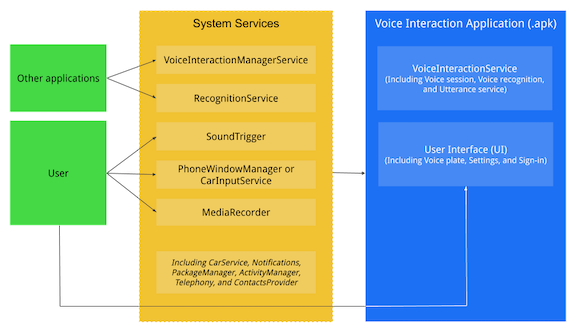Voice Interaction Service API, farklı potansiyel sesli kontrol uygulamaları için soyutlama sağlar. Uygulamalar, Uygulama geliştirme bölümünde açıklanan yönergelere göre geliştirilebilir. Bu entegrasyon kılavuzundaki içerikte, bu uygulamaların belirli bir Android Automotive OS (AAOS) sistem resmine nasıl entegre edileceği açıklanmaktadır.
Terminoloji
Bu kılavuzda aşağıdaki terimler kullanılır:
- Destek verileri. Sesli etkileşim oturumu başlatıldığında sistem, görünümleri ve ekran görüntülerini yakalayabilir ve bu bilgileri oturuma aktarabilir. Uygulamalar,
Activity#onProvideAssistData()veActivity#onProvideAssistContent()'i uygulayarak ek bilgiler gösterebilir. - Bas-konuş (PTT). Genellikle direksiyonda bulunan fiziksel sesli kontrol düğmesi.
- RecognitionService (RS). Uygulamalar tarafından
SpeechRecognizerAPI aracılığıyla kullanılan ses tanıma hizmeti. VIA'lar hemVoiceInteractionServicehem deRecognitionServiceöğesini içermelidir. - Dokunarak konuşma (TTT). Yazılım sesli kontrol düğmesi (genellikle sistem kullanıcı arayüzünün bir parçası olarak eklenir). Android'de bu işleme Asistan Hareketi denir.
VoiceInteractionService. VIA geliştiricisi tarafından uygulanan hafif sistem hizmeti. Seçilen hizmet, sistem hizmetinden önyükleme sırasında bağlanır ve her zaman çalışır.- VoiceInteractionSession (VIS). Bu sınıf, kullanıcı etkileşimi iş mantığını kapsar. Kullanıcıya sesli etkileşimin durumunu göstermekten, VoiceInteractor isteklerini işlemekten, yardım ve ekran görüntüsü verilerini almaktan sorumludur.
- VoiceInteractionSessionService (VSS). Sesli etkileşim oturumunu yönetmekten sorumlu olan, VIA'nın bir parçası olan bir hizmet. Bu hizmet, kullanıcıyla sesli etkileşim sırasında Android'in sistem hizmetinden bağlanır. Bu oturumun tüm iş mantığı
VoiceSessionsınıfında uygulanır. Bu hizmetin yalnızca tek bir kullanıcının ses oturumu sırasında etkin kalacağı garanti edilir. - Sesli Etkileşim Uygulaması (VIA). Sesli kontrol olarak hizmet etmek için tasarlanmış Android uygulaması (asistan olarak adlandırılır). Bu uygulamalar, manifest dosyalarına
VoiceInteractionServiceekleyerek tanımlanabilir. Sistemde aynı anda bu uygulamalardan yalnızca biri varsayılan olarak seçilebilir. Yalnızca varsayılan uygulama etkin kalır (bir sistem hizmetinden bağlanır) ve Bas-Konuş (PTT) veya Dokun-Konuş (TTT) etkinliklerini alır.
Sorumluluklar
Bu tabloda her tarafın sorumlulukları açıklanmaktadır.
| Otomobil üreticileri (OEM'ler) | AOSP | Uygulama Geliştiriciler |
|---|---|---|
|
|
|
Kullanıcı deneyimi şartları
Müşterilere iyi bir kullanıcı deneyimi sunma sorumluluğunun son sahibi OEM'lerdir. OEM'ler, önceden yüklenmiş tüm sesli etkileşim hizmetlerinin Önceden Yüklenmiş Asistanlar: Kullanıcı Deneyimi Kılavuzu'nda açıklanan şartları karşıladığından emin olmalıdır.
Temel Asistan deneyimi
Otomotiv Sesli Etkileşim Uygulaması (VIA), aşağıdaki işlemleri gerçekleştirir:
- [ZORUNLU] Sistem tarafından işlenen sesli etkileşim tetikleyicilerine (PTT, TTT) yanıt verin.
- [ZORUNLU] İlerleme durumunun görsel bir temsilini gösterin (ör. dinleme, işleme ve yerine getirme).
- [ZORUNLU] Kullanıcı isteklerinin anlaşıldığını ve tamamlandığını belirtmek için ses veya sesler kullanın.
- [ZORUNLU] Diğer uygulamalar için konuşma algılayıcı olarak hizmet vermelidir (SpeechRecognizer API'ye bakın).
- [SHOULD] Özel kelime tetikleyicisine yanıt vermelidir.
- [MAY] Kullanıcıların bu VIA'yı yapılandırabileceği bir ayarlar etkinliği gösterin (ör. izinler, özel kelime yapılandırması ve oturum açma).
- [MAY] Yardım verilerini işleme (
Intent#ACTION_ASSIST) - [MAY] Klavye Koruyucu'dan (kilit ekranı) sesli etkileşimi destekleme.
Bileşenler
Ses etkileşimi uygulamaları genel olarak aşağıdaki aktörlerle etkileşim kurar:

Şekil 1. Sesli etkileşim aktörleri
Ayrıntılar:
VoiceInteractionManagerService. Bu sistem hizmeti, varsayılan VIA'yı yönetmekten ve işlevlerini sistemin geri kalanına göstermekten sorumludur.RecognitionService. Bu hizmet, sistemdeki diğer uygulamalara konuşma tanıma özelliklerini gösterir.SoundTrigger. Özel kelime yönetimini uygular ve AlwaysOnHotwordDetector aracılığıyla VIA'lar tarafından kullanılabilir.MediaRecorder. Hem sıcak kelime algılama (CPU kullanıldığında) hem de konuşma tanıma için ses girişine erişim sağlar.PhoneWindowManager/CarInputService. Bu hizmetler, diğerlerinin yanı sıra önemli etkinlikleri işlemekten veVoiceInteractionManagerServicearacılığıyla PTT'yi VIA'ya yönlendirmekten sorumludur.User. Kullanıcı, Tetikleyiciler (PTT, TTT, Sıcak Kelime) veya Ses Plakası kullanıcı arayüzü aracılığıyla bir VIA ile etkileşimde bulunur.- CarService, Bildirimler, Medya, Telefon, Kişiler Sağlayıcı vb. VoiceInteractionSession tarafından kullanıcının komutlarını yerine getirmek için kullanılan hizmetler ve uygulamalar.
Otomotiv sektörüne özel kavramlar
AAOS, Android'den aşağıdaki yönlerden ayrılır:
- AAOS VIA'lar, normal Asistan işlevlerinin yanı sıra araç işlevlerini (ör. iklimlendirme, koltuklar ve iç ışıklar) de kontrol edebilir. OEM'lerin erişimi imtiyazlı izin izin verilenler listesine ekleme bölümünde açıklandığı şekilde doğru şekilde yapılandırdığı sürece bu işlevler CarPropertyManager API kullanılarak entegre edilebilir (Araç mülkünü okuma başlıklı makaleyi inceleyin).
- Özelleştirme ve tutarlılık, Otomotiv'de diğer form faktörlerinden daha alakalı. Bu yönergeleri uygulama hakkında daha fazla bilgi edinmek için Özelleştirme bölümüne bakın.

